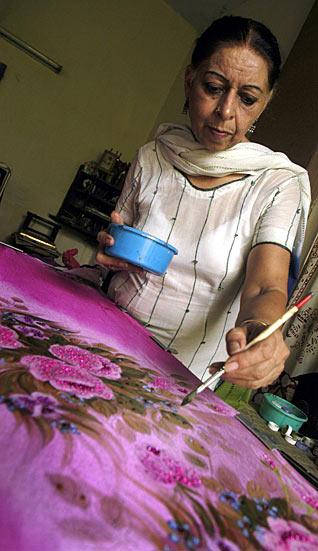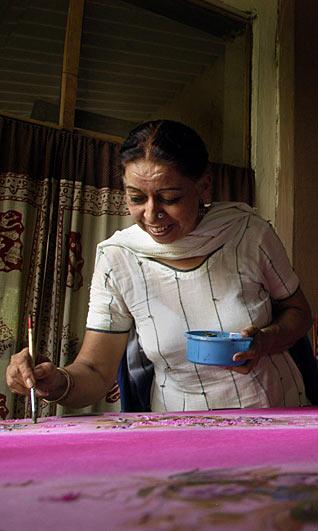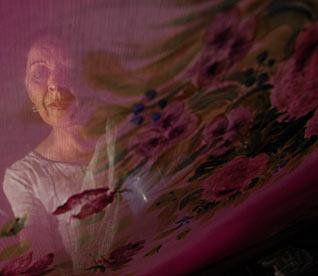Columnists
Fabric of Magic & Colour
by KHUSHWANT SINGHIf you thought Punjab's countryside was just about lush agriculture, you ought to think twice. At least, today's women of fashion don't think so: they know that many a hidden treasure lies in the villages and towns of this fair land.
Two such examples are easy to find, provided you're willing to brave Punjab's bumpy country-roads - to Soumindra Kaur Guron and Jyoti Kaur Sandhu. Each of the two, separately and unknown to each other, has created a niche for herself in hand-painted fabrics.
These women have a flair with the paint-brush, creating floral designs on salwar-kameez suits, dupattas, scarves, skirts, stoles, kurtis and saris.
For fifty-something Soumindra, her initiation into the fashion world dates back to the early nineteen-eighties when one of her nieces - the wife of a bureaucrat - gifted a dupatta hand-painted by her to the wife of the then Governor of Punjab. It opened a door to the world.
"My niece kept urging me to start painting and selling commercially, after she saw me wearing a suit that I had painted for myself. She requested me to paint a dupatta for the Governor's wife, who just loved it", relates Soumindra as we sit in her house in Village Hussainpur, about five kilometres from Ropar. Given the time of the day, there is no electricity. So, she offers me fresh lime instead of tea: I agree instantly.
For forty-year old Jyoti, it was the encouragement from friends and relatives that ultimately led to the launch of her career - they simply bought out everything she created, and demanded more and more.
Oblivious of each other while being almost two hundred kilometres apart, the two women have somehow transformed all the disadvantages that normally come with living in the relative isolation of a village.
Jyoti runs her workshop/studio in Village Sehrauli in the Amritsar district, and has turned it into what can be aptly described as a home-grown success.
"A cottage industry of sorts, which offers employment to local women, and puts the village on the world map", exclaims Adarsh Kaur Brar, a relative of Jyoti's.
Jyoti now markets her work under the brand, 'Jyoti Creations', to customers from all major North Indian cities. But, she recalls, she was mocked when she had first suggested the idea of a boutique to her husband.
‘ "A boutique in a village? na, na, na ...!" he had shaken his head,' she recalls.
However, her success has now allowed them to move to Sehrauli, after her husband had to leave a lucrative job in a tea-estate in Assam because of growing militancy by local insurgents. "OK, I was proved wrong," admits her husband, Parminder Singh Sandhu, who now enjoys tending to his farmland and doesn't interfere in her work.
Each of the two women, in her own style, just picks up the brush and paints free-style, using different kinds of fabric, be it cotton, linen or silk. Other village women who work in their studios carefully do the needle-work and sew on sippis (shells) and beads to add glamour to the garments.
"I mostly paint orchids, roses, chrysanthemums, irises or whatever comes to my mind", says Soumindra, who charges anywhere between Rs. 2000 and 5000 for a set of salwar-kameez. [Roughly, US$ 1.00 equals Rs. 44.00.]
"Nature is the best catalogue; how can anybody get tired of flowers?" she exclaims, when asked where she gets her designs. "I use vegetable dyes," she adds, as we stand next to a wooden frame. "I spread the garment on the frame, clip it down to keep it firm, and paint free-hand".
"I like to do florals", says Jyoti, who attributes this to her fruitful earlier stay in Assam, given its beautiful landscape. The lush countryside there helped her connect with nature, which invariably surfaces in her work. "My education at Jalandhar, where I studied Fine Arts, has also helped me develop further," she adds.
Other than painting, Jyoti is famous for "shadow-work", a form of embroidery. "She's probably the only one of this calibre doing it in North India - her creations are frequently on exhibit in major cities in Punjab and, of course, New Delhi," says Adarsh.
Her work has also helped transform the village and the life-style of its women in particular. Offering employment to over a hundred women who earn between Rs.1000 to 1200 per month, her venture is now seen as a sort of a mini-revolution. The secret of her success, according to one of her employees, is her strict quality control.
"After Bibi-ji paints on each piece of cloth herself, which may take her an hour or more, she hands it over to the artisans to embroider. Not losing sight of the work even for a moment, she guides them to do the job perfectly. This is one of the reasons why her customers, who get introduced to her work in exhibitions, then keep on coming back, over and over again, to purchase more, " boasts another employee.
"Soumindra maasi's market is now truly international," says Mansimran, a relative. "It appears that every girl getting married nowadays must have suits designed by her. No such shopping trip is complete any more without her creations, be it Sikhs and Punjabis visiting from abroad, or a big, fat, local Punjabi wedding!"
No wonder, during the wedding season, Soumindra finds herself overworked as orders pour in for huge numbers. "I thought the fashion of hand-painted fabrics would slowly wean out, but it's still going strong more than twenty years later," she exclaims. She has recently opened a new workshop/studio in Barog in the hills of Himachal Pradesh, in order to continue operations through the summer heat.
Interestingly, during her first visit to the USA where she had gone to meet her daughter Henna eight years ago, an American woman, impressed by Soumindra's work, had asked her to paint furniture for her exclusive store in Sherman Oaks, a suburb of Los Angeles.
A number of local celebrities seem to have been smitten by her art during her visit. Singer Nancy Sinatra (Frank's daughter), for example, had her room painted in roses by Soumindra.
Despite the fact that she has never had any formal training in the art, it has also attracted the attention of many renowned designers. In 1994, a full sequence of her creations was showcased at a fashion show in Hong Kong by none other than the acclaimed designer, J.J. Vallaya.
"He asked me to do a line of clothing in seven different colours. And the embellishments as well," beams Soumindra.
She is now widely known for more than her creative hand-painting. Her genius in everything she touches makes her stand apart. Alongside her professional work, she has slowly restored her family haveli in Village Ladran in the Ludhiana district where visitors can visit, and even have a meal with a prior appointment.
Known as The Haveli, it is the ancestral property of her late husband, Captain Amarjit Singh, who traced his roots to the Nishan-e-wala Sikh Misl. It now serves as an exclusive life-style show-room for antique furniture. Visitors can spend the day touring the complex, or shopping within its facilities. The royal treatment meted out by the hosts makes it a memorable day. And so do the Punjabi staples, sarson-da-saag and makki-di-roti, accompanied by the obligatory lassi.
Country roads, here I come !
[Courtesy: India Today]
Conversation about this article
1: jazy (Los Angeles), March 21, 2007, 4:33 PM.
Great article. Soumindra surely is very talented... Sikh women rock!
2: Qudsia (Pakistan), January 28, 2009, 6:54 AM.
I really like your work. I would love to learn more about your designs and the colours you use in painting. How can I get in touch with you?
3: Baljeet (Bazpur, Uttaranchal, India), June 11, 2009, 6:50 AM.
This hot pink dupatta looks really nice. Where can I get to see some more of your designs?
4: Paramjeet Kaur Dhillon (Centreville, Virginia, U.S.A.), August 19, 2010, 2:39 PM.
I am very impressed with the shown work of Jyoti Kaur and Soumindra Kaur. How can I get in touch with them?
5: Sonia Bhasin (Panchkula, India), July 26, 2011, 9:15 AM.
Great work. Want to know more about you and your designs.
6: Sonia Bhasin (Panchkula, India), December 30, 2011, 4:31 AM.
Very imaginative. Want to know more about your designs.
7: Daljit (Chandigarh, Punjab), July 24, 2013, 1:05 AM.
I want to know which colourings you are using and what are the others things which we can use for painting on fabric.
8: Tanu Kaur (Winnipeg, Manitoba, Canada), November 04, 2013, 1:34 PM.
I really like your work, it's so good. How can I contact you?
9: Shaffy (Kotkapura, Punjab ), November 26, 2013, 10:26 AM.
I want these type of suits. So how can I get them? How can I contact you?
10: Gurpreet (Noida, India), May 13, 2014, 7:35 AM.
Love your stuff. Want to know more about it.
11: Farida Virani (Mumbai, India ), September 28, 2014, 9:52 PM.
I want one white duppata with roses. How do I get in touch with you?
12: Rajwinder Singh Bains (Surrey, British Columbia, Canada), April 28, 2017, 2:20 PM.
Wow! ... what an amazing article. She is surely a gem. Where and how can I meet her or maybe talk to her about buying her pieces of art?





